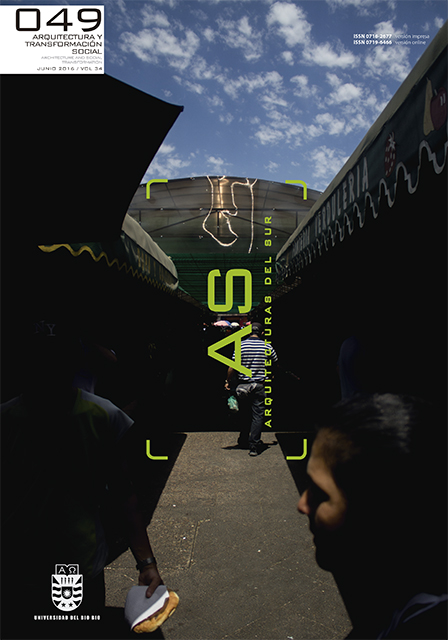Incremental transformations in consolidated informal housing: The case of Santa María de las Lomas, Guayaquil
DOI:
https://doi.org/10.22320/07196466.2016.34.49.02Keywords:
family, social transformation, housing need, grouped dwellings, typologiesAbstract
The maximum impact that an architectural project can have in the social transformation of a neighborhood is not to change society through the project, but to make it possible for society to change through architecture. In the case of informal housing, this transformation occurs through small, incremental changes in each dwelling. These can be classified into three types: improvised, trial and error, and approximations, which give rise to logical global behaviors that can mean significant advances in the social structure of the neighborhood.
This article presents progress of research carried out at the Catholic University of Santiago de Guayaquil, which seeks to find mutual influences between the physical transformations of the house, and the social transformation of the family in the informal neighborhood of Santa María de las Lomas, in Guayaquil. To this end, comparative diagrams of both transformation systems are produced, which describe a trigger for change that is neither architecture nor society, but rather a dialectic relationship between the two.
Downloads
References
AL, Stefan. Villages in the City: a Guide to South China’s Informal Settlements. 1a edición. Hong Kong: Paramount Printing Co., 2014.
BALMOND, Cecil. Informal. Londres: Prestel Publishing, 2002.
DARWIN, Charles. El origen de las especies. Lima: Fondo Editorial de la Cultura Peruana, 2012.
DE TERESA, Ignacio. Relación entre las características tipo- lógicas funcionales de la vivienda unifamiliar informal y su evolución espacial. Guayaquil: SINDE, 2015.
JOHNSON, Steven. Sistemas emergentes o qué tienen en común las hormigas, las ciudades y el software. México D.F.: Fondo de Cultura Económica, 2003.
KOOLHAAS, Rem. Acerca de la ciudad. Barcelona: GG, 2014.
LAMARCK, Jean Baptiste. Filosofía zoológica. Barcelona: editorial Alta Fulla, 1986.
MOSER, Caroline. Gente de barrio, vidas extraordinarias: activos y reducción de la pobreza en Guayaquil, 1978-2004. Santiago de Chile: Ediciones SUR, 2010.
RUEDA, Salvador. La ciudad compacta y diversa frente a la conurbación difusa. En: GARCÍA-GERMAN, Javier, De lo mecánico a lo termodinámico, por una de nición energé- tica de la arquitectura y del territorio. Barcelona: GG, 1997, pp. 153-170.
THOMPSON, D’Arcy. Sobre el crecimiento y la forma. 16a edición. Madrid: Ediciones Akal, 1961.
WILLENSKY, Uri y RESNICK, Mitchel. Thinking in Levels: a Dynamic Systems Approach to Making Sense of the World. Journal of Science Education and Technology, 1999, vol. 8, n° 1, pp. 3-19.
ZULOARK. El futuro no es futurible. De pequeños creíamos que era cuestión de esperar. Revista Circo [en línea], 2009, no 156, pp. 5. [Consultado 30 mayo de 2016]. Disponible en: http://www.mansilla-tunon.com/circo/ epoca7/pdf/2009_156.pdf
Downloads
Published
How to Cite
Issue
Section
License
Copyright (c) 2016 Ignacio de Teresa Fernández-Casas

This work is licensed under a Creative Commons Attribution-ShareAlike 4.0 International License.
The content of the articles published in each issue of Arquitecturas del Sur is the sole responsibility of the authors and does not necessarily represent the opinion of University of the Bío-Bío.
The authors will maintain their copyright; however, they will guarantee the journal the right to first publication and dissemination of their work. The publication of the article in Arquitecturas del Sur will be subject to the Creative Commons International license (CC BY-SA) that allows others to adapt: remix, transform and build on the material for any purpose, even commercially; share: copy and redistribute the material in any medium or format, as long as the authorship and first publication in this journal are acknowledged by citing them correctly, and their new contributions are under a license with the same terms.














 Programa de Información Científica/Concurso Fondos de Publicación de Revistas Científicas 2018/ Proyecto Mejoramiento de Visibilidad de Revistas UBB (Código:FP180007)
Programa de Información Científica/Concurso Fondos de Publicación de Revistas Científicas 2018/ Proyecto Mejoramiento de Visibilidad de Revistas UBB (Código:FP180007) 
